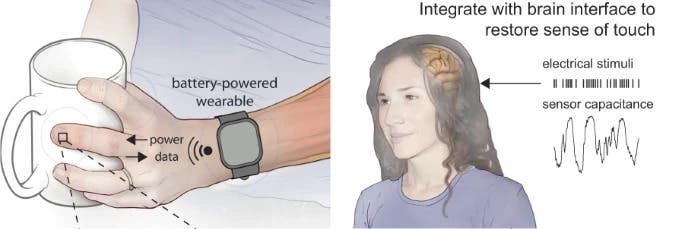Life-changing implantable tactile sensors offer new hope for paralyzed individuals
Traditional tactile sensors used in wearables and robotics have often fallen short in providing the necessary touch feedback.

The sense of touch is critical to dexterous use of the hands and thus an essential component of efforts to restore hand function after amputation or paralysis. (CREDIT: Nature Microsystems and Nanoengineering)
Tactile mechanoreceptors, those tiny sensors embedded in our skin that allow us to feel sensations and interact with our environment, are an essential part of our daily lives. They enable us to grasp objects, detect pressure, and experience the world through our sense of touch.
However, for individuals suffering from paralysis, the loss of these receptors can be a significant barrier to regaining their independence and quality of life.
Traditional tactile sensors used in wearables and robotics have often fallen short in providing the necessary touch feedback. But now, a groundbreaking study published in the journal Microsystems & Nanoengineering has unveiled a potential solution that could change the lives of those living with paralysis.
Researchers have long sought a way to restore the sense of touch in paralyzed hands. Brain-machine interfaces, which have shown promise in enabling individuals to control robotic limbs using their thoughts, have been lacking the crucial fingertip tactile sensing required for dexterity. Enter implantable tactile sensors developed using Micro-Electro-Mechanical Systems (MEMS) technology, offering new hope for closed-loop hand reanimation in paralyzed individuals.
Related Stories:
The study presents a remarkable leap forward in neuroprosthetic technology with the development of an implantable tactile sensing system. This system could revolutionize how patients recover hand function after paralysis, offering a path towards enhanced functional independence and improved quality of life.
At the heart of this breakthrough lies a microfabricated capacitive pressure sensor, specifically designed for subdermal placement in fingertips. Unlike traditional wearable tactile sensors that remain on the skin's surface, this implantable device interacts directly with a patient's paralyzed hand, providing a more natural and immersive experience.
The implantable sensor is a marvel of engineering, comprising a custom integrated circuit for wireless powering and data transmission. Encapsulated in a laser-fused hermetic silica package, it offers enhanced durability and safety for long-term use within the human body.
Illustration of envisioned closed-loop hand reanimation treatment for paralysis. The implantable wireless tactile sensors developed in this work are intended to be part of an artificial sensory feedback pathway (green). The tactile signals acquired by the sensors would be wirelessly conveyed to a brain stimulator that activates a somatosensory area in proportion to the sensor output, resulting in a sense of touch. In addition, volitional movement would be restored by stimulating paralyzed muscle in proportion to neural activity recorded in a motor brain area (blue). (CREDIT: Nature Microsystems and Nanoengineering)
Prior to its real-world application, the device underwent meticulous validation, including simulations, benchtop assessments, and even primate hand testing. Remarkably, the sensor demonstrated an impressive ability to accurately measure applied skin forces, achieving a resolution of 4.3 millinewtons (mN).
The true magic of this implantable sensor comes into play when its output is encoded in the brain via microstimulation. This process provides tactile feedback to the user, effectively simulating the natural sense of touch.
Implantable, wireless, battery-free tactile sensing system. (CREDIT: Microsystems & Nanoengineering)
This groundbreaking approach has the potential to vastly improve the functionality and user experience of neuroprosthetic systems. Furthermore, it opens the door to a wide range of other implantable sensing applications, marking a significant advancement in medical technology.
As one member of the research team enthusiastically states, "This implantable system represents a significant breakthrough in tactile sensing technology. It's a giant step towards restoring natural hand functions and improving the quality of life for individuals with paralysis."
In vivo pilot study of sensor package implantation in a nonhuman primate fingertip. (CREDIT: Microsystems & Nanoengineering)
Beyond restoring hand function and improving tactile perception for patients with paralysis, this technology represents a pioneering step forward, offering endless possibilities for various other implantable sensing system applications.
The future looks brighter for individuals living with paralysis, thanks to these innovative and life-changing developments in the field of neuroprosthetics.
Note: Materials provided above by the The Brighter Side of News. Content may be edited for style and length.
Like these kind of feel good stories? Get the Brighter Side of News' newsletter.
Joshua Shavit
Science & Technology Writer | AI and Robotics Reporter
Joshua Shavit is a Los Angeles-based science and technology writer with a passion for exploring the breakthroughs shaping the future. As a contributor to The Brighter Side of News, he focuses on positive and transformative advancements in AI, technology, physics, engineering, robotics and space science. Joshua is currently working towards a Bachelor of Science in Business Administration at the University of California, Berkeley. He combines his academic background with a talent for storytelling, making complex scientific discoveries engaging and accessible. His work highlights the innovators behind the ideas, bringing readers closer to the people driving progress.



